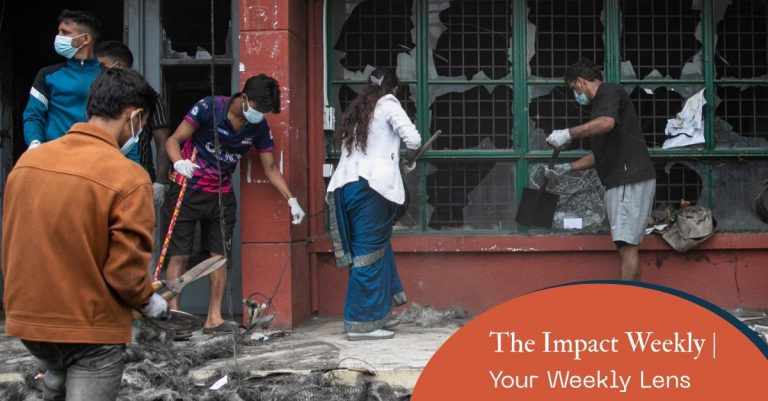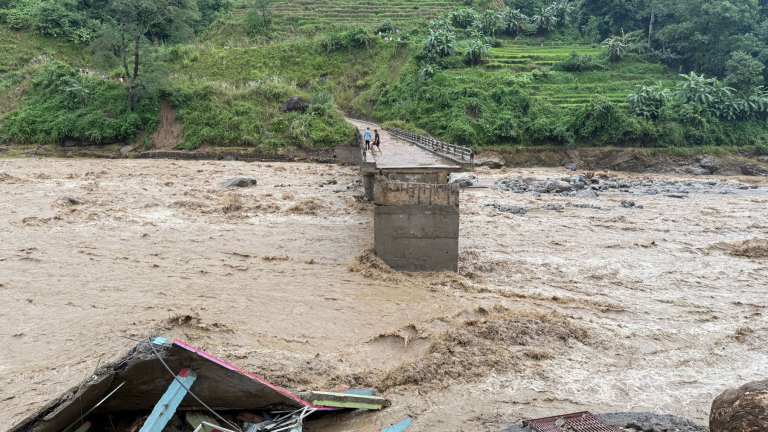Recent two-day protests and mob violence have caused nationwide disruption, crippling public institutions, damaging public and private properties, and wreaking havoc on private businesses across Nepal. Most accounts of this destruction come from various media reports, as formal damage assessment is still underway. We take a glance at the damage caused during the two-day protest and the ensuing violence.
Loss of lives
- 74 deaths reported so far
- Over 2,100 injured, many in critical condition
Fatalities include:
- 45 protesters (aged 18–64) killed by police shootings
- 3 police personnel killed in mob violence on September 9
- 16 total from burnt buildings in Kathmandu, Dharan, Biratnagar, and Pokhara
- 5 juvenile inmates and 5 adult prisoners shot while attempting to escape detention facilities across the country
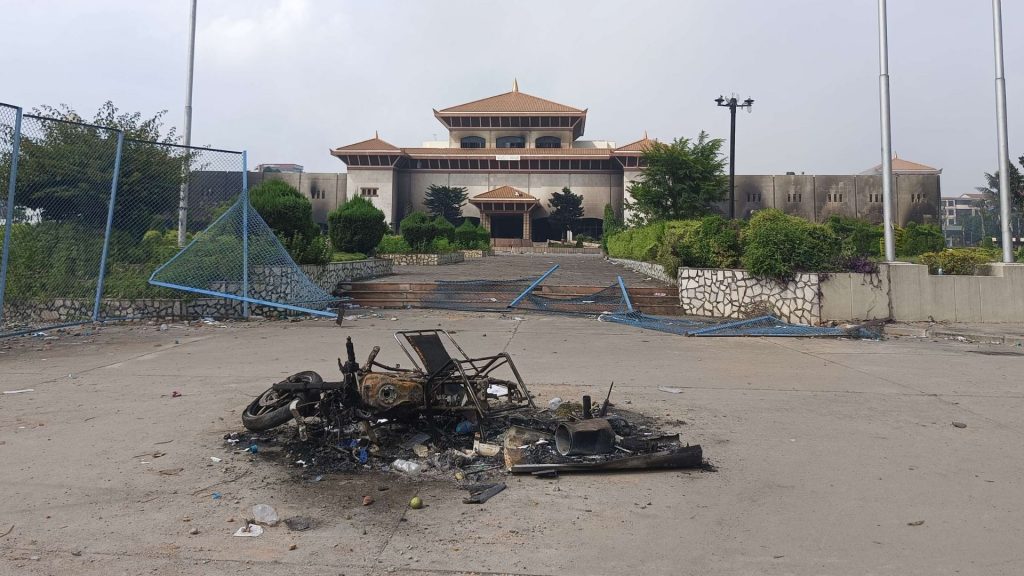
Severe harm to public assets
Protesters torched major public assets that symbolise the country’s institutions, including Singha Durbar, the lower house (House of Representatives), the Supreme Court, the President’s and Prime Minister’s residences, and ministers’ quarters in Bhainsepati.
An architectural and historical landmark, Singha Durbar was originally built in 1908 as a royal palace and later fully converted into the seat of Nepal’s central administration. Once considered Asia’s largest palace, its reconstruction after multiple fires has cost billions of rupees.
The parliament building, which was initially constructed as an international conference venue, was completed in 1993 at an estimated cost of over NRs one billion, funded by a Chinese grant. It was converted into a parliamentary building in 2007, following the political changes that led to the establishment of a federal democratic republic in Nepal.
Other sites torched include the President’s Office (formerly Sheetal Niwas), the Supreme Court, the Prime Minister’s official residence in Baluwatar, and the newly constructed Ministers’ Residence.
Sheetal Niwas was built in 1923 during the Rana regime. Following the regime’s abolishment, it was later used as the State Guest House and then as the Ministry of Foreign Affairs. It underwent costly renovations after the monarchy’s end and was converted into the President’s Office.
The Supreme Court building was established in 1956, with later expansions costing hundreds of millions. The Prime Minister’s official residence in Baluwatar, built in the mid-20th century and maintained at high public expense, was also touched and vandalised. The newly constructed Ministers’ Residence (Special Building Project) that housed federal ministers, the Chairman and Vice-Chairman of the National Assembly, and the Deputy Speaker of the House of Representatives in Bhaisepati, Lalitpur, was built at a cost of over NRs 3 billion.
Key ministries such as the Office of the Prime Minister, home affairs, finance, agriculture, and ministerial departments, such as the roads and transport, also suffered significant damage. Government offices across the country were torched and vandalised.
Around 2,000 government vehicles, including over 800 four-wheelers, were destroyed, with major damage reported at Singha Durbar, the Supreme Court, Department of Roads, and several ministries, as well as at provincial offices, local government offices, and police stations.
Most government vehicles had only third-party insurance, which covers damage to others but not to the vehicles themselves, leaving the state without financial protection for its own losses.
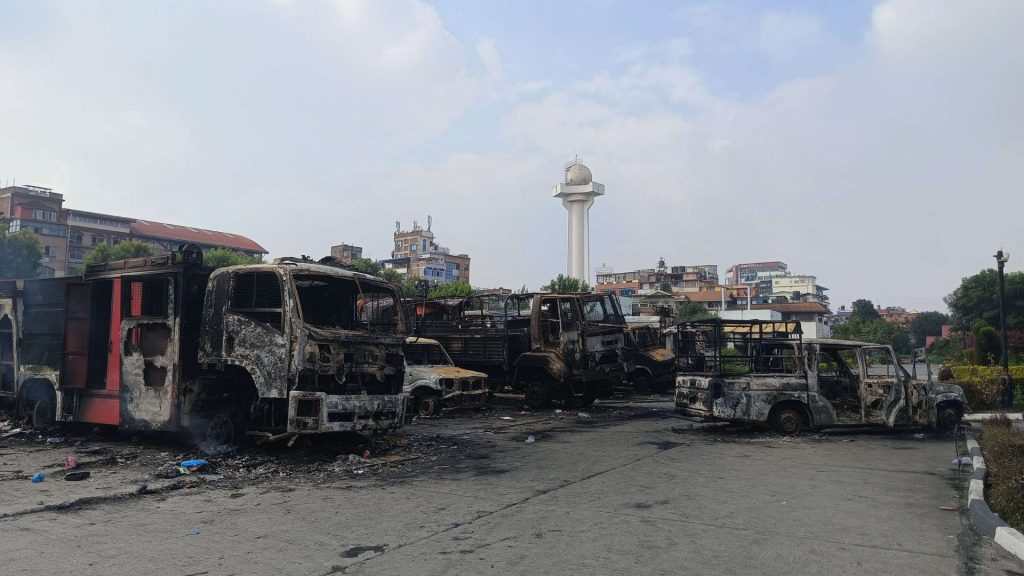
Loss of critical government records
Arson at several government offices has also burned crucial government records and critical equipment. Most notably, key records at the parliament building, the Supreme Court, several district courts, the PMO, and the President’s residence, as well as the CIAA, were lost to fire and vandalism.
The Supreme Court particularly sustained heavy damage, with courtrooms, active case files and evidence, archival records, and information technology systems severely affected. The damage is believed to disrupt its administration and judicial process significantly.
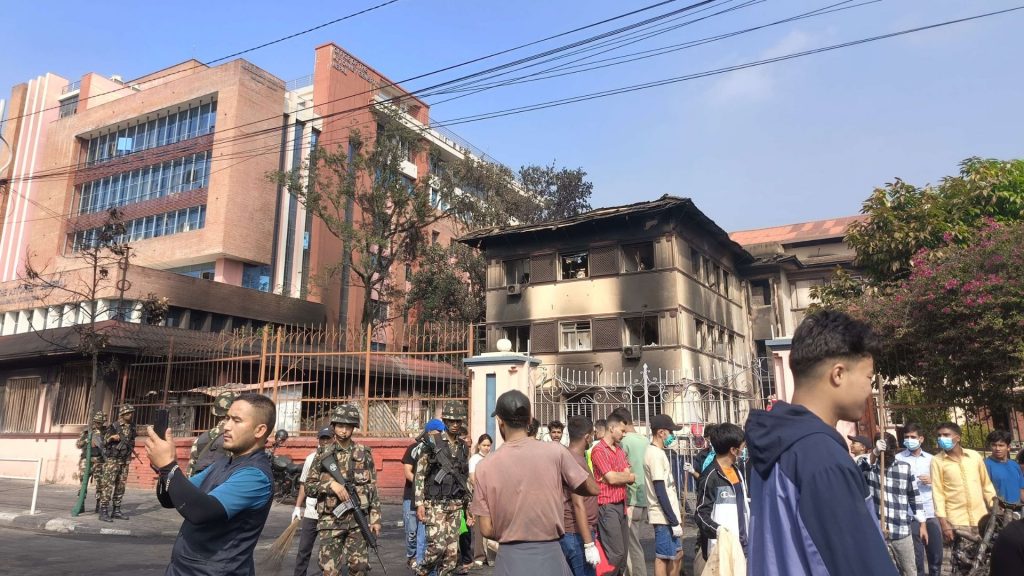
Some protestors also ransacked the Commission for the Investigation of Abuse of Authority (CIAA) headquarters, where they torched vehicles, burned archives, and stole hard drives, laptops, and forensic tools, in what officials believe was a coordinated attempt to steal and destroy corruption case files.
A deliberate blaze at the Department of Transport Management (DoTM) destroyed its machine for smart-card licences and embossed number plates. Approximately 20,000 printed driver’s licences and embossed number plates ready for distribution were also burnt.
Damage at local levels
Around 300 local government offices were attacked on September 9th, including municipal buildings in Bharatpur, Biratnagar, Pokhara, and Kirtipur, along with essential municipal vehicles such as fire trucks and garbage trucks.
According to the National Association of Rural Municipalities, 29 rural municipality offices were torched or vandalised, with 18 destroyed and 11 partially damaged. Additionally, 36 ward offices were destroyed nationwide, and 25 were partially affected, with at least 12 rural municipalities losing their building to arson.
The destruction spans from Biratnagar in the east to Kanchanpur in the far west, affecting both urban and rural areas. Koshi Province suffered the heaviest damage, with offices of eight rural municipalities destroyed. In Bagmati Province, four rural municipalities were completely burned, and one was partially damaged.
Preliminary assessment from Birgunj Sub-Metropolitan alone estimates the damage to NRs 1.15 billion. The municipal headquarters, ward offices, and key health centers were severely damaged and vandalised. Officials are still cataloging additional losses for a detailed report, but the initial findings showcase a severe impact on administrative operations.
Correspondingly, Pokhara Sub-Metropolitan City saw 26 of its 33 ward offices lost to arson. Alongside this, government offices such as Pokhara’s District Administration Office, Department of Transport, Land Revenue, and the district court were also torched and vandalised.
Protest takes toll on the private sector
The private sector has borne severe losses, largely due to large business groups’ perceived nexus with bad politics and corruption, along with infiltration of political and anarchic elements on the second day of the protest.
Bhatbhateni Supermarket reported heavy devastation, with 21 out of its 28 nationwide outlets damaged, including 12 destroyed by fire. Human casualties were no less severe, as 13 individuals lost their lives in the blaze at different outlets.
Overall, the supermarket reported losses of around NRs. 1.1 billion, with NRs. 600 million worth of goods destroyed by fire, and nearly NRs. 50 million lost in looting. Despite the destruction, the company has vowed to support its 10,000 employees, maintain operations where possible, and provide full Dashain bonuses.
Five-star hotels, including Hilton Kathmandu and Hyatt Regency, were attacked and set on fire during the protests, resulting in estimated losses in the hospitality sector of NRs 25 billion. Several resorts and hotels in Pokhara, the country’s premier tourism destination, also sustained damage, including Bagaicha Resort, Bar Peepal Resort, Hotel Goodwill, Hotel Sarovar, Ansuvara, and Pokhara Event Center.
Additionally, the Chandragiri Hills cable car service was also damaged with protesters burning down their lower station, which includes its main operational unit, administrative offices, ticket counters, restaurants, the Gongola parking area, and storage units. This overall destruction brought operations to a complete halt.
The Sunrise Convention Center in Godawari, Lalitpur, which was built at Rs 810 million with a 3,000-seat capacity, was razed by arson. Built to host national and international events, it now lies in ruins, wiping out years of investment and dealing a heavy blow to Nepal’s event management prospects, and even its local economy.
Media outlets, including Kantipur Media Group (KMG) and Annapurna Post, had their offices attacked. KMG, located in the Central Business Park in Thapathali, suffered extensive damage from arson and vandalism. The entire business park, which houses offices of different companies, was burnt.
Ncell’s headquarters in Lainchaur, along with its regional offices in Mahendranagar, Dhangadhi, and Pokhara, were also vandalized and set on fire, with extensive damage reported. Ncell has filed formal complaints at the police station with footage as evidence, and requested those who took the stolen items return them to the nearest police station, warning of legal consequences otherwise.
Industrial plants of Chaudhary Group and Golchha organization were also affected, with reports of damage to their facilities.
Nepal’s automobile dealer hub in Thapathali (Kathmandu) was also heavily impacted. Showrooms of Tata, Hyundai, Mahindra, Suzuki, and CG Motors were looted and burned, destroying around 30 brand-new cars with a reported loss of around NRs 15 billion. In contrast to government vehicles, private vehicles have insurance coverage.
According to the Federation of Nepal Chamber of Commerce and Industries (FNCCI), which has been cataloging the damage, it has provided an estimated loss of nearly Rs 800 billion. The overall loss means disruption in the product line, jobs, livelihood, and business confidence.
Financial intermediaries face uncertainty amidst chaos
68 bank branches and nearly 69 ATMs were affected nationwide.
Many branches in commercial complexes and government buildings also became targets. Despite the threats, vaults remained firm, and no significant cash reserve breach was found.
However, Rastra Banijya Bank’s branch inside the Parliamentary buildings reported a loot of 50 million rupees in cash and 18 kg of gold.
Nepal Rastra Bank also remained secure during the protests, with no breaches reported at headquarters, though its Economic Research Division experienced some disruption.
Despite the chaos that unfolded, NRB Governor Biswo Poudel assured that the central bank’s core operations were secured and that the vital payment systems remained fully intact. Earlier, on September 12, the central bank issued directives to banks, financial companies, and payment-related institutions instructing them to ensure uninterrupted operations while adhering to national security protocol.
However, following the unrest and an earlier slowdown in consumption and credit demand, the outlook for the banking industry in the coming days remains uncertain.
Insurance sector in turmoil amid heavy claims
Nepal Insurance Authority (NIA) issued a directive to maintain business continuity, while also reminding the policyholders to submit their claims promptly. It also warned that any delays, unclear liability determination, or lack of notification by the insured should be reported to NIA for appropriate action.
Yet, unlike the banks, insurers are expected to suffer direct and substantial losses due to extensive damage to infrastructure, looting, and arson.
Preliminary data on non-life insurance from NIA indicate a total of 2,478 claims filed, amounting to NRs 22.3 billion. Bagmati Province, as an epicenter of the damage, recorded 1,343 claims worth nearly NRs 18 billion, far outstripping other provinces. Property insurance claims carried the largest weight, with 538 claims for NRs 18.6 billion in losses, while motor insurance produced the largest count at 1,778 claims, though less value was attached.
The heaviest burden fell on a narrow set of insurers: Oriental Insurance alone faced NRs 52 billion from 73 claims, with Siddhartha Premier trailing close at NRs 50 billion from 279 claims, followed by IGI Prudential with NRs 27.7 billion from 170 claims, shouldering the large share of the market’s total loss.
Amid these events, Nepal’s first reinsurance company, Nepal Reinsurance Company (Nepal Re), is also anticipated to face a significant impact. The damages sustained at Bhatbhateni Superstore highlight its exposure, as it covers losses related to buildings, inventory, and maintenance under the “riot and terrorism” category—where insurers bear 35% of the liability and Nepal Re assumes the remaining 65%.
ICRA Nepal has also placed multiple insurers—including Shikhar Insurance, SALICO, Siddhartha Premier, NLG Insurance, United Ajod, and Nepal Reinsurance—on “Watch with Negative Implications”, signaling that the rating is likely to be downgraded once the credit uncertainty is resolved.
NEPSE plunges by 6% after 10-day hiatus
As unrest spilled from the streets to the financial market, NEPSE halted its trading on Sept 8th.
When NEPSE reopened after a 10-day hiatus on 18 September, investors rushed to sell. In six minutes of trading, which included three circuit breakers, the index dropped by 6% closing at 2,511. Turnover plunged by 86% to NRs 728.7 million from NRs 5.2 billion in the prior session.
Investor panic dominated the market: 217 companies closed in the red, while only nine companies gained, highlighting a sharp loss of confidence.
The same day, the MoF formed a four-member committee to study distortions and problems in the country’s capital market and recommend long-term structural and policy reform to boost investors’ confidence aimed at strengthening investors’ confidence.
The next trading day, the market opened with an index gain of 111.7 points, a turnaround also attributed to the Security Board of Nepal (SEBON)’s decision to reverse the last 15-minute average price rule.
Overall, the protest has left Nepali institutions and the financial system reeling, causing both human loss and economic disruption. Recovery will require a coordinated rebuilding of infrastructure and confidence in it, restoration of critical services, and enforcement of strong safeguard measures to prevent such a crisis in the future.
Stay tuned for next week as we shift focus from ledgering damage to the country’s blueprint on recovering and rebuilding what we lost.


